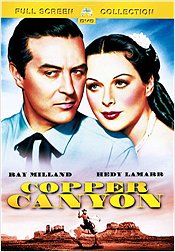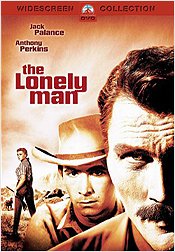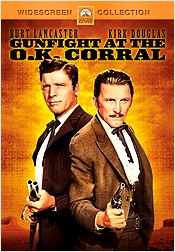 |
Site created 12/15/97.

page created: 6/2/03
 Barrie Maxwell - Main Page |
||||||||||||||||||||||||||||||||||||||||||||||||||||||||||||||||||||||||||||||||||||||||||||||||||||||||||||||||||||||||||||||||||||||||||||||||||||||||||||||||||||||||||||||||||||||||
| For
this outing, I'm going to turn my attention to westerns from
Paramount, prompted by that company's recent release of eight
westerns on DVD. I'll cover the somewhat surprising record that
Paramount has in the genre over the past century, indicate DVD
availability, and also provide reviews of the eight recent Paramount
western DVD releases. The usual update of forthcoming classic
releases on DVD will be found at the end. Paramount's Westerns Record When you think of westerns and the major studios, Paramount is seldom the first studio that you think of as a producer of such films. With the exception of MGM, which never managed a lasting identifiable western style, most of the others had certain areas of strength. Warner Brothers had Errol Flynn in a number of rousing A productions in the late 1930s - early 1940s (Dodge City, Virginia City, They Died with Their Boots On, San Antonio); 20th Century Fox had a number of prestige westerns during the same period, frequently with Henry Fonda (Jesse James, Return of Frank James, The Ox-Bow Incident, My Darling Clementine); Universal was very active in the 1950s with a series of James Stewart/Anthony Mann efforts (Bend of the River, The Far Country, Winchester '73) as well as a continuing series of Audie Murphy films. Columbia is closely identified with a number of superior Randolph Scott westerns during the 1950s (Santa Fe, Man in the Saddle, The Stranger Wore a Gun, Ten Wanted Men, The Tall T). Even RKO turned out a number of serviceable major westerns in the 1940s starring a mix of Robert Mitchum (Blood on the Moon), Randolph Scott (Trail Street, Return of the Badmen), and Dick Powell (Station West). Paramount, for those who remember, had Cecil B. DeMille who occasionally turned his hand to western spectacle (The Plainsman, Union Pacific, Northwest Mounted Police), but beyond that? Well, as it turns out, there's a fair bit beyond that. Dating back from the present to the middle of the silent era, Paramount and its forerunner Famous Players-Lasky made approximately 300 westerns (out of a total studio output exceeding 3000 titles). About 95% of them came prior to 1970 and during that time, production was fairly steady ranging between 35 and 55 films each decade, but with a peak of 75 westerns in the 1930s. Part of the reason for the peak was the fact that Paramount distributed the Harry Sherman-produced Hopalong Cassidy B westerns from 1935 to 1941. This added about half a dozen titles to Paramount's own A western productions during those years. Paramount's earliest westerns during the silent period were highlighted by a number of Cecil B. DeMille films including The Squaw Man, Call of the North, and The Virginian (all in 1914). By the end of the decade, William S. Hart was releasing some of his fine work through Paramount (Wagon Tracks, The Toll Gate [both 1919], and Wild Bill Hickok [1923]). The epic western started to make its mark with Paramount's 1923 production of James Cruze's The Covered Wagon and later The Pony Express. Paramount also had a real money-maker in the 1920s - a series of westerns based on the books of popular western novelist Zane Grey. At least two Zane Grey westerns a year appeared from 1921 to 1928. Jack Holt (The Thundering Herd, Wild Horse Mesa [both 1925]) and Richard Dix (The Vanishing American [1925]) were the main stars. With the coming of sound, Paramount continued with its Zane Grey films, often remaking the silent versions although frequently retaining the action sequences shot for the originals. The films proved to be a good training ground for budding stars such as Gary Cooper (Fighting Caravans [1931]) and Randolph Scott (Rocky Mountain Mystery [1935]). As this series wound down, it was gradually replaced by Paramount's involvement in the previously-mentioned Hopalong Cassidy westerns, starring William Boyd. Among B westerns, this was a superior series, still able to generate enjoyment for western film fans today. Production values were superior and the Cassidy character as played by Boyd was and is appealing. The series began with 1935's Hopalong Cassidy and continued at Paramount for 40 more films until 1941's Secrets of the Wasteland. (There would be another 25 "Hoppy" films, but they would be released by UA after Paramount sold the rights to them.) The 1930s was the decade of the B series western and major western productions were few and far between. Paramount, in effect, dominated the field. After an early success with The Virginian (1929, with Gary Cooper), Paramount had four epics later in the decade: King Vidor's The Texas Rangers (1936, with Fred MacMurray and Jack Oakie and plenty of action), Cecil B. DeMille's The Plainsman (1936, with Gary Cooper), Frank Lloyd's Wells Fargo (1937, with Joel McCrea in a rather stodgy affair), and DeMille's best sound epic Union Pacific (1939, with Barbara Stanwyck and Joel McCrea). After the carefully-paced action and flair of Union Pacific, DeMille's next film for Paramount - Northwest Mounted Police (1940)- was a dud. Slow, uninteresting, and saddled with obvious back projection for what should have been entertaining outdoor sequences, this film seemed to set the mold for the 1940s. Outside of the final Hopalong Cassidy efforts, none of the studio's major 1940s westerns generated much excitement. Included in the lackluster output were Rangers of Fortune (1940, with Fred MacMurray), and California (1947, with Ray Milland). Some hope for the future was offered by Alan Ladd in Whispering Smith (1948). The 1950s was a decade of resurgence for the western throughout Hollywood with the emphasis on "adult' and "psychological" westerns, even though many traditional efforts still were produced. Paramount could point with pride to Shane (1953, with Alan Ladd, directed by George Stevens) and John Sturges' Gunfight at the O.K. Corral (1957, with Kirk Douglas and Burt Lancaster), but there were other fine titles too: The Furies (1950, Walter Huston), Denver and Rio Grande (1952, John Payne), Run for Cover (1955, James Cagney), The Tin Star (1957, Henry Fonda), and Last Train from Gun Hill (1959, Kirk Douglas). For the 1960s, Paramount's western contribution could mainly be summed up in two words - Lyles and Wayne. John Wayne's best westerns of the decade came through Paramount, including John Ford's The Man Who Shot Liberty Valance (1962), Henry Hathaway's The Sons of Katie Elder (1965), Howard Hawks' El Dorado (1967), and Henry Hathaway's True Grit (Wayne's 1969 Oscar-winning performance). Lyles - producer A.C. Lyles, that is - was responsible for a number of formulaic though entertaining westerns whose key ingredient was a host of old time western performers given their last shots at the genre. Typical were Law of the Lawless (1964), Town Tamer (1965), Apache Uprising (1966), and Hostile Guns (1967). As the decade drew to a close, Paramount got in on the spaghetti western bandwagon through its joint production of Sergio Leone's Once Upon a Time in the West (1968, with Charles Bronson and Henry Fonda). The 1970s represented but a slow deflation to the effective end to date of Paramount's western production involvement with 1978's uneven Goin' South (with Jack Nicholson). (There would be a western satire made in 1985 called Rustlers' Rhapsody, but the less said about that the better.) Otherwise, worth noting from the 1970s are A Gunfight (1971, with Kirk Douglas), Bad Company (1972) featuring the always-reliable Jeff Bridges, and The Shootist (1976) which was a moving end to John Wayne's film career. Paramount Westerns on DVD As with a number of the studios nowadays, the issue of who owns the home video rights to Paramount films is not simple. Aside from titles that are now in the public domain, Paramount retains the rights to all its silent films. The early sound films are a different matter. We've probably all heard that Universal controls the Paramount films made during the 1930s and 1940s, but the exact cutoff date has never been clear to me. My thanks to the website editor of Superman Web Central for providing much of the following information. When many of the studios sold off their catalogs in the late 1940s in order to raise cash in the wake of the lawsuit that forced then to divest themselves of their own film theatres, Paramount found itself dealing with MCA (Music Corporation of America). MCA purchased the rights to all of Paramount's sound films released prior to 1950. There were several exceptions, however. Due to various rights concerns, Paramount managed to retain control over three 1940s A titles (Sorry Wrong Number, Samson and Delilah, and The Miracle of Morgan's Creek). Several series films had their rights already assigned to other parties, so they were not included in the MCA deal either. The Hopalong Cassidy westerns are an example of this. MCA established EMKA Ltd. in the late 1950s and the Paramount sound library became its responsibility - thus the reason one sees EMKA cited as the copyright renewing agency on the older Paramount titles. Universal subsequently purchased MCA, thus effectively bringing the rights to the Paramount pre-1950 titles under Universal's control, where they remain at present. Paramount retains the rights to all its films released in 1950 and subsequently. The following table indicates those Paramount westerns that are available on or announced for DVD. Titles currently available and worthy of your attention due to a combination of film content and disc quality are in YELLOW. |
||||||||||||||||||||||||||||||||||||||||||||||||||||||||||||||||||||||||||||||||||||||||||||||||||||||||||||||||||||||||||||||||||||||||||||||||||||||||||||||||||||||||||||||||||||||||
|
||||||||||||||||||||||||||||||||||||||||||||||||||||||||||||||||||||||||||||||||||||||||||||||||||||||||||||||||||||||||||||||||||||||||||||||||||||||||||||||||||||||||||||||||||||||||
| Reviews The eight westerns recently released on DVD by Paramount are quite a mixed bag. They range from the traditional plots of Copper Canyon (1950) and Big Jake (1971) to the somewhat more psychological fare of The Lonely Man (1957) and Gunfight at the O.K. Corral (1957). Nevada Smith (1966) was inspired by the character of the same name played by Alan Ladd in The Carpetbaggers. Four of the titles (Little Big Man [1970], Rio Lobo [1970], A Man Called Horse [1970], Big Jake [1971]) were originally Cinema Center productions released through National General, but their rights were acquired by CBS and are being released on DVD on CBS's behalf by Paramount. Several of these eight titles (such as Little Big Man and Gunfight at the O.K. Corral) have been in great demand. Others (such as Copper Canyon and The Lonely Man) less so; their appearance at this time is due to the availability of source elements that have remained in good condition. All the DVDs come with no extras. This is consistent with Paramount's general policy with respect to catalog titles, although I don't personally like it. How difficult or expensive can it be to include a trailer at least? Copper Canyon There's nothing too original about this 1950 western. It's little more than a B dressed up in A clothes - good production values including Technicolor photography, fine location work, a couple of top stars, and a reasonable smattering of well-known character actors. The story involves a vaudeville sharpshooter named Johnny Carter who is actually a former hero in the Confederate Army, now trying to outrun his past. His new identity does not fool a group of ex-Confederate miners who are trying to make a living mining copper in Copper Canyon. They seek Johnny's help in trying to protect themselves from Unionists and corrupt lawmen who are trying to take over their claims. At first reluctant to become involved, Johnny is gradually won over to their cause despite his deepening romantic entanglement with Lisa Roselle who is part of the Unionist group. |
||||||||||||||||||||||||||||||||||||||||||||||||||||||||||||||||||||||||||||||||||||||||||||||||||||||||||||||||||||||||||||||||||||||||||||||||||||||||||||||||||||||||||||||||||||||||
| One
gets the impression that more was originally intended for this film.
Despite the traditional lines of the plot, it does possess more
depth and complexity than a standard western script. After gradually
developing the various plot strands, the whole story is unexpectedly
quickly brought to a conclusion. The way the Unionists are finally
captured and Lane Travis overcome is disappointingly brief and
unrealistic, and the wrap-up of the rest of the plot strands is so
sudden as to leave your head spinning. The whole thing is over in 83
minutes. I'd be surprised to learn that Paramount invested the
production effort it did, including fine Technicolor location work
near Flagstaff, Arizona and the more commonly-used Vasquez Rocks in
California, without originally seeing the film as a longer, more
fully-rounded production. Despite this, the film retains good
entertainment value and is a worthy investment of one's time. Paramount's full frame DVD (in accord with the film's original aspect ratio) is sumptuous-looking. The colours are bright and vibrant throughout. The source material looks to be in good condition with only the occasional speckle and bit of debris to mar the image. Edge effects are minimal. The mono sound track is quite adequate. There are no extras. Recommended. The Lonely Man Yes, you've seen this plot before - gunfighter tries to reform - but this 1957 western is so well acted, beautifully filmed, and respectfully transferred to DVD that it's another title well worth the price of admission. Jacob Wade is the outlaw gunfighter trying to turn respectable, but it's not easy. The local town doesn't want him; his old gang is stalking him; and a son whom Jacob apparently deserted hates him. It all comes down to the usual final showdown in town, but this one has a bit of a twist to it. |
||||||||||||||||||||||||||||||||||||||||||||||||||||||||||||||||||||||||||||||||||||||||||||||||||||||||||||||||||||||||||||||||||||||||||||||||||||||||||||||||||||||||||||||||||||||||
| The
Lonely Man was originally shot in VistaVision, a format
in which the image frame is twice as big as the standard 35-mm frame
because it is shot and developed sideways on the film. The high
definition black and white transfer for the DVD was done from a
positive fine grain element, yielding outstanding results. The
1.85:1 anamorphic image features a beautifully-rendered gray scale
with deep blacks and pure whites. Only minimal minor speckles and
debris are at all apparent. The mono track is again quite adequate.
There are no extras. Recommended. Gunfight at the O.K. Corral The Wyatt Earp saga ranging from the Dodge City days, to the shootout with the Clanton gang at Tombstone's O.K. Corral, and the aftermath has been presented in whole or in part in numerous films over the years. Law and Order (1932, Universal) is an effective early sound version. Better known are John Ford's My Darling Clementine (1946, Fox) and the recent Tombstone (1993, Touchstone) and Wyatt Earp (1994, WB) featuring Henry Fonda, Kurt Russell, and Kevin Costner respectively as Earp. 1967's Hour of the Gun (UA) had James Garner playing Earp, with the story mainly focusing on the events after the O.K. Corral shootout. Directed by John Sturges, it effectively was a sequel to a 1957 film that Sturges had also directed - Gunfight at the O.K. Corral. |
||||||||||||||||||||||||||||||||||||||||||||||||||||||||||||||||||||||||||||||||||||||||||||||||||||||||||||||||||||||||||||||||||||||||||||||||||||||||||||||||||||||||||||||||||||||||
| Paramount
obviously considered the film one of its important titles of 1957.
It was produced by the illustrious and consistent Hal Wallis and
featured a quality cast in addition to the two headliners of
Lancaster and Douglas. Co-starring were Rhonda Fleming, Jo Van
Fleet, and John Ireland with good supporting roles for the likes of
Earl Holliman, Lyle Bettger, Dennis Hopper, DeForest Kelley, Martin
Milner, Whit Bissell, and Lee Van Cleef. Dimitri Tiomkin contributed
a fine score with a title song (sung by Frankie Laine). Film
shooting extended over ten weeks and included location work at
several Arizona locales. The O.K. Corral shootout sequence was
carefully choreographed and required three days to film what turned
out to be a ten-minute sequence on screen. The results constitute
the highlight of the film, though how accurate it was compared to
what really happened is questionable. Gunfight at the O.K. Corral is also a VistaVision film. The 1.85:1 anamorphic DVD was created using the original negative as the source material. An expensive (though not complete) restoration was undertaken and the results are impressive. Colours are vibrant and image detail is excellent. Minor speckling is occasionally evident and edge haloes sometimes apparent, but these are minor quibbles against what is a strikingly good-looking picture. The film's mono tack is very good, managing considerable presence during gunfire sequences and providing a very pleasing rendition of Tiomkin's score. There are no extras. Recommended. |
On to Part Two
Barrie Maxwell - Main Page
 |
| Site
designed for 1024 x 768 resolution, using 16M colors and .gif 89a
animation. © 1997-2015 The Digital Bits, Inc., All Rights Reserved. billhunt@thedigitalbits.com |


